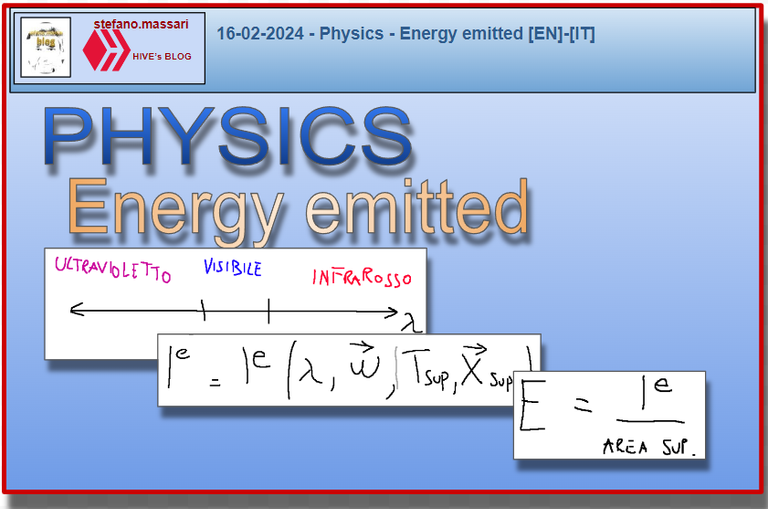16-02-2024 - Physics - Energy emitted [EN]-[IT]

~~~ La versione in italiano inizia subito dopo la versione in inglese ~~~
ENGLISH
16-02-2024 - Physics - Energy emitted [EN]-[IT]
Basic concepts
Thermodynamics is a very broad branch of physics.
To understand it you need several basic concepts and in each article I will try to indicate these different basic concepts.
The study of gases in thermodynamics is very important and encompasses both the study of perfect and real gases,
When we talk about gases we must have specific heats in mind.
Below are some things about specific heats.
-The ratio between the specific heats at constant pressure and constant volume of a gas is of particular importance in calculations regarding the expansion and compression of the gas.
-The ratio between the specific heats at constant pressure and constant volume of a gas is always greater than 1
-The following formula where both pressure and volume appear represents an isentropic thermodynamic transformation. In thermodynamics, an isentropic transformation is a transformation that occurs at constant entropy

Energy emitted
To characterize the energy emitted according to the electromagnetic radiation spectrum we can first take a look at the image below.
The image represents the spectrum of electromagnetic radiation relating to the subdivisions in the field of thermal radiation.

Note: The electromagnetic spectrum of a radiation is the distribution in energy, or in wavelength (λ), or in frequency (ν) of the intensity of that electromagnetic radiation.
To continue the analysis, let's consider having a surface of a certain material that emits energy in the form of electromagnetic waves in all directions at different wavelengths.
The emitted radiative intensity, i.e. the one radiated, per unit of time will be a function of the wavelength λ, the direction ω and the state functions of the emitting body.
The intensity emitted can mathematically be described as follows:

Where
I e = intensity emitted
While the total hemispheric emissive power is the radiant thermal energy emitted by a surface per unit area, in all directions and on all wavelengths.
This is indicated with an E.

Where:
E = total emissive power [W/m2]
The total hemispheric emissive power depends on many variables linked to surface factors such as the degree of finish and temperature.
Conclusions
Total hemispheric emissive power is the radiant thermal energy emitted by a surface, per unit of time and area, in all directions and on all wavelengths.
Request
Thermal radiation is one of the mechanisms for transmitting energy as heat. Have you ever studied it in school? Have you heard about it often when it comes to analyzing homes?

16-02-2024 - Fisica - Energia emessa [EN]-[IT]
Concetti base
La termodinamica è un ramo ella fisica molto ampio.
Per comprenderla servono diversi concetti base ed in ogni articolo proverò ad indicare questi diversi concetti base.
Lo studio dei gas in termodinamica è molto importante e abbraccia sia lo studio dei gas perfetti che quelli reali,
Quando parliamo di gas dobbiamo avere in mente i calori specifici.
Qui di seguito alcune cose che riguardano i calori specifici.
-Il rapporto tra i calori specifici a pressione e a volume costante di un gas è di particolare importanza nei calcoli riguardanti l'espansione e la compressione del gas.
-Il rapporto tra i calori specifici a pressione e a volume costante di un gas è sempre maggiore di 1
-La seguente formula dove appare sia la pressione che il volume rappresenta una trasformazione termodinamica isoentropica. In termodinamica, una trasformazione isoentropica è una trasformazione che avviene a entropia costante

Energia emessa
Per caratterizzare l’energia emessa secondo lo spettro di radiazione elettromagnetica possiamo prima dare un’occhiata all'immagine qui sotto riportata.
L’immagine rappresenta lo spettro della radiazione elettromagnetica relativa alle suddivisioni nel campo della radiazione termica.

Nota: Lo spettro elettromagnetico di una radiazione è la distribuzione in energia, o in lunghezza d'onda (λ), o in frequenza (ν) dell'intensità di quella radiazione elettromagnetica.
Per continuare l’analisi consideriamo di avere una superficie di un certo materiale che emette energia sotto forma di onde elettromagnetiche in tutte le direzioni a diverse lunghezze d’onda.
L’intensità radiativa emessa, cioè quella irraggiata, per unità di tempo sarà funzione della lunghezza d’onda λ, della direzione ω e delle funzioni di stato del corpo emettitore.
L’intensità emessa matematicamente possiamo descriverla come segue:

Dove
I e = intensità emessa
Mentre il potere emissivo emisferico totale è l’energia termica raggiante emessa da una superficie per unità di area, in tutte le direzioni e su tutte le lunghezze d’onda.
Questo viene indicato con la E.

Dove:
E = potere emissivo totale [W/m2]
Il potere emissivo emisferico totale dipende da tante variabili legate a fattori superficiali come il grado di finitura e la temperatura.
Conclusioni
Il potere emissivo emisferico totale è l'energia termica raggiante emessa da una superficie, per unità di tempo e di area, in tutte le direzioni e su tutte le lunghezze d'onda.
Domanda
L'irraggiamento termico è uno dei meccanismi di trasmissione dell'energia come calore. L'avete mai studiato a scuola? Ne avete sentito parlare spesso quando si tratta di analizzare le abitazioni?
THE END
Thank you very much for this detailed explanation
I like it!
Thanks for stopping by. One of the main concepts expressed in this article is that as regards the spectrum of electromagnetic radiation, the nomenclature relating to the subdivisions in the field of thermal radiation is that composed of the fields: ultraviolet, visible, infrared
Ne ho sentito parlare in alcune occasioni.
In questo articolo si parla soprattuto di irraggiamento, cioè il trasferimento di energia tra due corpi per mezzo di onde elettromagnetiche. Bisogna ricordare sempre che quando parliamo di irraggiamento e onde elettromagnetica, parliamo di irraggiamento termico e cioè irraggiamento di energia termica.
I think I can remember that this has to deal with the first law of thermodynamic
Thanks to be here... One of the more complex concepts in this article is what total hemispheric emissive power represents.
This is the radiant heat energy emitted by a surface, per unit time and area, in all directions and on all wavelengths.
@tipu curate 2
A scuola non l'ho mai studiato ma magari dovevo e non lo so visto che proprio non studiavo 😁😁😁😁
Upvoted 👌 (Mana: 31/51) Liquid rewards.
Hahaha, la tua ironia è spettacolare... gli studi a scuola sull'energia emessa li abbiamo fatti.. ma ricordarsi cosa sia il potere emissivo emisferico totale mi sembra troppo per chiunque a meno che non sia un fisico e stia lavorando in un laboratorio di fisica... Per curiosità il potere emissivo emisferico totale è l'energia termica raggiante emessa da una superficie, per unità di tempo e di area, in tutte le direzioni e su tutte le lunghezze d'onda... e uno si dovrebbe ricordare questa cosa?! :)
Thank you so much for always making it mindful to explain the basics terms of thermodynamic in the simple form for us to understand
In this article we mainly talk about radiation, that is, the transfer of energy between two bodies by means of electromagnetic waves. We must always remember that when we talk about radiation and electromagnetic waves, we are talking about thermal radiation and that is radiation of thermal energy. Instead, the most complex part is the meaning of the total hemispheric emissive power which is the radiant thermal energy emitted by a surface, per unit of time and area, in all directions and over all wavelengths. It is not thermal energy radiating in one direction and per wavelength as some confuse it.